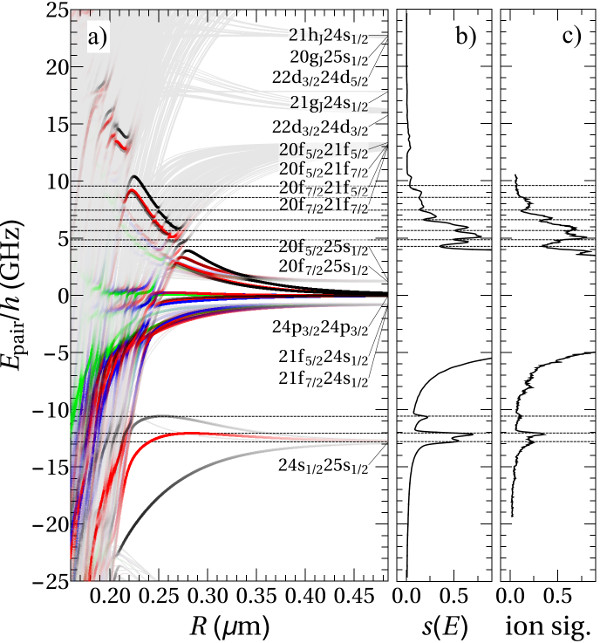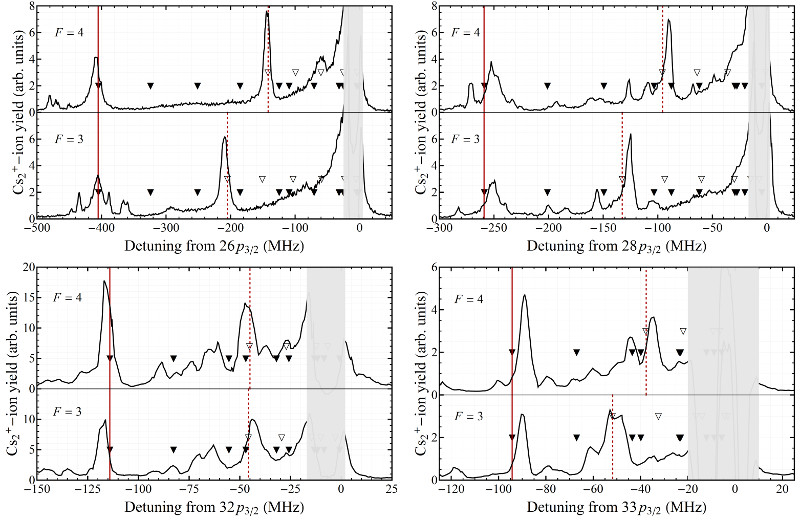Spectroscopy of Ultracold Samples
In our experiments, laser-cooled cesium atoms at a temperature of 40 µK and a density of 1012 atoms/cm3 are excited to np3/2 Rydberg states with pulsed and continuous-wave UV laser radiation [1]. Depending on the intensity of the light field, we observe different molecular resonances in the Rydberg excitation spectra resulting from i) the interactions between two Rydberg atoms [2,3] or ii) the interaction between a Rydberg atom and one ground-state atom located inside the Rydberg orbit [4]. We aim for a deeper understanding of the energy level structures and dynamics of these weakly bound molecules by measuring high-resolution photoassociation spectra and comparing the experimental results to spectra calculated on the basis of detailed models of the interaction potentials.
Resonances originating from excitation of Rydberg-atom pair states
Upon irradiation of the ultracold gas of Cs atoms with an intense pulse of UV laser radiation with 150 MHz Fourier-transform-limited frequency width we observe spectral resonances which we attribute to the correlated excitation of two atoms into interacting Rydberg-atom pair states. The underlying mechanism is the long-range interaction of an induced multipole moment on one atom and an induced multipole moment on the other atom, the strongest contribution typically being the dipole-dipole interaction. However, we also observe resonances that originate from higher-order terms in the multipole expansion, e.g. the dipole-quadrupole interaction. In contrast to the interaction between two dipole moments, this interaction does not conserve the electronic parity. The electronic interaction of the two Rydberg atoms thus causes an additional torque on the relative motion of the two atoms. The coupling is facilitated in our system by the quasi-degeneracy of rotational states of the collision complex with opposite parity [2]. Additionally, “window resonances” appear as spectral minima, and can be directly linked to avoided crossings between different potential energy curves [3]. The quantitative agreement between simulation and experiment is used to validate our potential model of the interaction between two Rydberg atoms, which in turn can be applied to describe various different phenomena, as Penning ionisation in ultracold Rydberg samples, and Rydberg-excitation blockade effects.

A new scattering channel in long-range Rydberg molecules
The scattering of a quasi-free Rydberg electron, being only weakly bound to its ion core, off a ground-state atom can lead to molecular potentials that support several vibrational states. In our experiments, we have recorded photoassociation spectra with a continuous-wave UV laser (3 MHz bandwidth) and measured effects of the internal quantum state of the ground-state atom on these molecular potentials: The binding energies of some of the long-range Cs2 Rydberg molecules, observed close to atomic cesium np3/2 Rydberg states in our experiments, show a strong dependence on the hyperfine state (F=3,4) in which we prepare the ground-state atom. This dependency is explained by a model of the electron-ground-state-atom scattering that includes singlet and triplet scattering channels and the hyperfine structure of the ground state. Our experiments thus yield the first experimental determination of a zero-energy singlet scattering length in electron-alkali collisions.

[1] H. Saßmannshausen, F. Merkt and J. Deiglmayr, "High-resolution spectroscopy of Rydberg states in an ultracold cesium gas", Phys. Rev. A 87(3), 032519:1-10 (2013), doi: external page 10.1103/PhysRevA.87.032519
[2] J. Deiglmayr, H. Saßmannshausen, P. Pillet, and F. Merkt, "Observation of dipole-quadrupole interaction in an ultracold gas of Rydberg atoms", Phys. Rev. Lett. 113, 193001 (2014), doi: external page 10.1103/PhysRevLett.113.193001
[3] H. Saßmannshausen, F. Merkt, and J. Deiglmayr, "Pulsed excitation of Rydberg-atom-pair states in an ultracold Cs gas", Phys. Rev. A 92, 032505 (2015), doi: external page 10.1103/PhysRevA.92.032505
[4] H. Saßmannshausen, F. Merkt, and J. Deiglmayr, "Experimental characterization of singlet scattering channels in long-range Rydberg molecules", Phys. Rev. Lett. 114, 133201 (2015), doi: external page 10.1103/PhysRevLett.114.133201
For further information, please contact us or learn more about our research by reading one of our Publications.